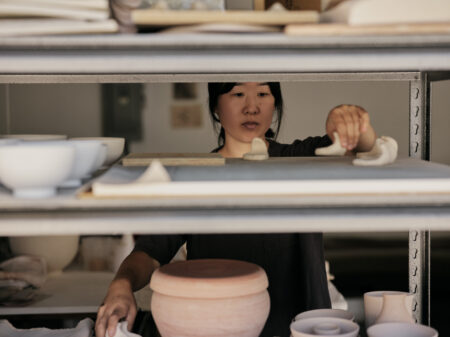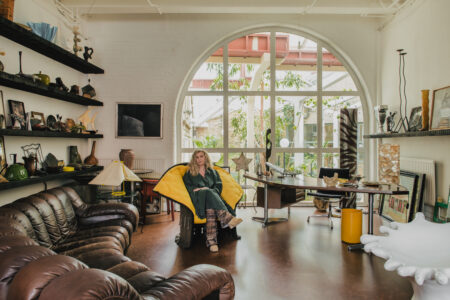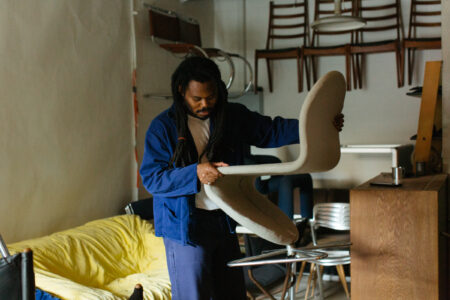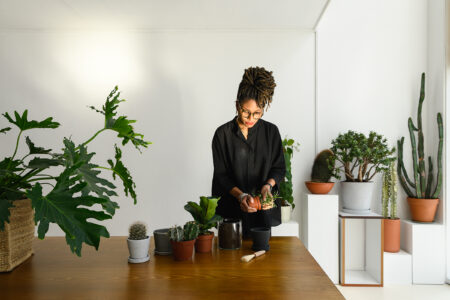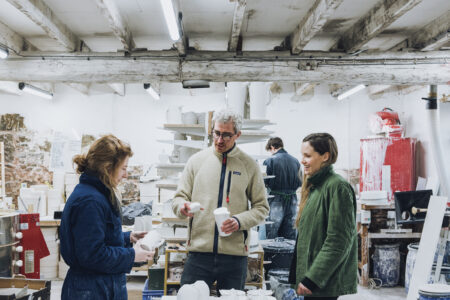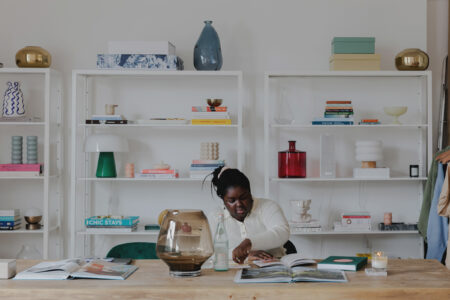Sabine Zetteler’s studio in Hackney, east London, is a place of bright ideas and budding talent

Zetteler is celebrating its 10th birthday. The communications and consultancy agency, founded by its namesake Sabine Zetteler, has spent a decade supporting and nurturing talent by connecting emerging creative names with more established ones. It’s a year full of milestones, then, as it also marks the opening of Zetteler’s new beautifully designed headquarters, a studio on the seventh floor of a warehouse in Hackney, east London. Supportive, uplifting and full of bright ideas, it’s an epitomisation of the brand. And just like Zetteler, it has people at its heart, for along with her five team members, Sabine opens the doors to freelancers and charities who need a place to work. When it’s buzzing with different personalities, she says, the studio is at its best.
Sabine tasked Rhonda Drakeford of Studio Rhonda to makeover the formerly industrial space, having spent years admiring the interior designer’s use of colour. There were two boxes in particular that needed ticking: the founder considers the environment of utmost importance and has severe hearing loss, so the result would be as sustainable as possible and deaf-friendly. With the brief met and the office in full swing, Sabine invites us for a tour and discusses Zetteler turning 10, her love of good design and why the studio is also a brilliant place to throw parties.


Sabine: “I have a burning passion for the arts, what they do to people’s lives and how they help us make sense of the world. I feel like a creative person in some respects, but I’m not a creative practitioner. I like thoughtful beautiful things, and beautiful things are often made to last. The environmental side of me needs things to be made well.
“My job is to connect people from behind the scenes and create masses of opportunities for up-and-coming creatives by introducing them to established journalists. In turn, the journalists are finding out about some really exciting projects that they might not have heard about otherwise. Seeing a career take off and knowing that you were a part of it is totally thrilling.
“Throughout my career, I’ve been called naïve by a lot of people for the way in which we pick clients. It’s a really emotional process. We have to get a certain number of goosebumps to take something on. For example, we’ve just taken on a studio called JA Projects, which is run by a brilliant architect called Jayden Ali. His approach is just so different to what you see around you in architecture. His team is working on a project in south London at the moment and they have employed people who speak the native tongue of the majority of the residents. They really think about who they’re building spaces for. They listen to the communities.


“People often say they think it’s impressive that we only work with people we like and companies doing good in the world, but I just find that totally obvious. Why would we wake up in the morning and spend time promoting something we don’t think is going to make a positive change?
“Now, 10 years on and that’s a massive part of why we are successful: journalists know that we won’t take on something that we don’t believe in. Among all the hype and noise of PR, we have a genuine degree of trust with our contacts.
“The building we’re based in is quite special. We’re surrounded by hands-on creatives: architects, designers, ceramicists, makers, artists. We actually had a ginormous space downstairs in this building, but when Covid hit, it didn’t make sense to keep it. We inquired if there were any other spaces in this building – our dream was to be on the seventh floor; sometimes, we’d just get the lift up here to look at the view. So, when we found out there were two 1,000sq ft spaces, we jumped in one and our friends Camille Walala and Julia Jomaa jumped in the other.

“I have always worked in offices with white walls and lots of fun books and plants, but I really wanted this place to be more considered. Lockdown gave us the luxury of months to plan and think about the placement of all our things. I’ve known Rhonda of Studio Rhonda, who worked on the design of the space, for years. I’ve screen-grabbed so much of her work on Instagram. I love how she uses colour architecturally, such as by painting blocks of colours on the ceiling to create zones within rooms.
“As I’m deaf, part of the brief was to make sure there were enough soft materials used, so that when someone drops a teaspoon on the other side of the room, for instance, it doesn’t make me hold my head in my hands because it’s made my hearing aids ring. There are some noises that can be such a nightmare. It was important we built walls to prevent that from happening. One of my other requests was to have a beautiful cube with glass bricks in the middle of the space for more private gatherings and presentations.
“My mother is from Finland and I love Nordic culture, but I’m not super Scandi or a ‘50 shades of white’ type. I like navy, maroon, mustard, terracotta. I said to Rhonda, ‘No beige!’ but half of the office is painted a sand colour. And it’s amazing – it feels like you’re in a womb. When the sun hits the walls, they just glow. It’s absolutely beautiful. The colour palette of the studio is considered yet playful.


“Everything in the office, in terms of the furniture and design, has been built to last. Nothing is throwaway and we didn’t scrimp on anything. It’s a very supportive space that’s as environmentally conscious as possible, and, in that sense, it’s reflective of Zetteler as a brand. My parents are from two countries – my father is Dutch – that are really environmentally conscious. Their governments have more stringent rules on recycling and things like that, so I was just brought up in a home where I was very aware of the environment, and that’s fed into everything I do.
“We want our office to feel alive. We make sure we can host freelancers who might not have anywhere to work except home. Collectively between us here, we know lot of community groups: I’m a trustee for a human rights charity and I volunteer at a homeless shelter, and Emily, my colleague, works with Extinction Rebellion and for the Samaritans, and three years ago, we set up Design Can, a platform fighting for equity in the design sector. Our team might be small, but the network is big. Recently, the AA Young Trustees and New Architecture Writers used the space.
“We’ve hosted some really lovely parties in here. Because it’s not a residential building and there aren’t residents close by, you can play tunes pretty loudly and late and it doesn’t matter. It’s a really nice space to be in the day and it’s great at night too.
“It’s going to be really fun to see how the studio works for different people. It will always be the Zetteler office, but it feels full of life when there are lots of different people are working here. I love that the space is useful for more than just us. I think that’s what makes it extra special.”






